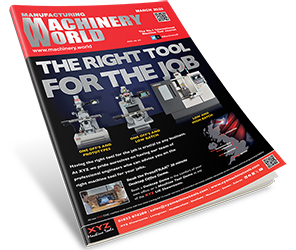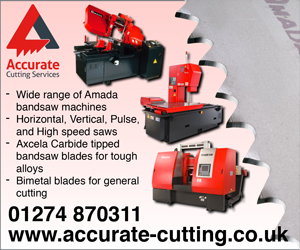The main focus was on digitalisation, automation, additive processes and electromobility
Frankfurt am Main, January 2020. – This year’s EMO Hannover took place from 16 to 21 September 2019 under the banner of “Smart technologies driving tomorrow’s production!”. Forward-looking topics such as the digital networking of machine tools, the Industrial Internet of Things (IIoT) and the umati universal machine interface were presented at the world’s leading metalworking trade fair. The increasing importance of the digital transformation in the machine tool sector was demonstrated by numerous exhibitors who linked their machine tools by means of innovative software solutions. Below we present some of the highlights from the fair to give an impression of the range of innovations on show at EMO Hannover. These include a selection of new machine tool developments but also digitalisation and automation solutions that are now integral parts of modern production environments. They are followed by innovations in clamping technology and precision tools, which are indispensable fields for metalworking. New CAD/CAM system functions for component design, production process simulation and control system programming are also presented. Finally, the report highlights ways in which future topics such as electromobility and additive manufacturing can be closely interlinked in order to raise the efficiency and precision levels of manufacturing processes.
Machine tools
Liebherr-Verzahntechnik GmbH from Kempten is following the trend towards integrating various work processes into gear cutting machines. One such example presented by the gearing specialist at EMO Hannover was the LK 280 DC gearing machine. This combines the roller peeling process with automated deburring during machining time, thus enabling the complete machining of bulk-produced gears, for example in the automotive industry and in gear manufacturing. The machine is operated using the LHGearTec programming system, which is integrated into the control system. This also offers access to Liebherr’s online platform, which in turn provides access to further useful functions, so-called LH services. These include live remote monitoring of the machine status. A further engineering highlight at the fair was the digital machine twin. This yields major advantages, especially during the machine development stage. It allows virtual checking and optimisation of the mechanical structure and kinematics before actual implementation, plus virtual measurement of the machining times.
The rising demand for automation solutions is also boosting demand for industrial robots in particular. These require high-precision cycloidal gears in order to achieve high reduction ratios. During their production it is crucial that high accuracy levels down to the single-digit micrometre range are maintained when the bores and the tooth profile are machined. The Viper 500 MFM machine tool made by the Hückeswagen-based machine manufacturer Klingelnberg performs this. It is a task which cannot be accomplished using standard machining cycles, especially not in a way which is time-efficient. Up to four cycloidal gears are ground simultaneously in a single clamping. One of the machine’s advantages is the integrated measuring device. This enables individual control and documentation of the manufactured cycloidal gears. If a machining result does not meet the required specifications, the measuring software calculates appropriate correction values. These are automatically transferred to the machine control for direct post-processing to ensure compliance with the tolerance specifications. The machine operator merely has to enable this. There is no need for time-consuming handling, process adaptation or manual transfer of the correction values.
As a reaction to the increasing importance of e-mobility, EMAG from Salach presented innovative manufacturing solutions for e-motor components at EMO Hannover. The outer surface of electric motor rotors, which are welded together from sheet metal packages, must be reworked. The surface quality requirements here are so high that only a conventional external longitudinal turning process with a low feed rate is permissible. Surfaces can be produced without the usual torsion encountered during turning by using a peeling turning process which produces a rolling movement of the tool on the workpiece, meaning that the cutting edge contact point is continuously shifted. Such surface quality levels can otherwise only be achieved by grinding. In addition, the high feed rate allows the process time to be significantly reduced compared to alternative machining processes, thus increasing the cost-effectiveness.
In addition to mechanical and electrochemical processing devices, EMAG also showcased machines for laser welding, laser cleaning and laser structuring. Combined laser cleaning in a machine – i.e. removing dirt or oil residues from components and then structuring the surface – can prepare component element surfaces for joining by gluing or lacquering. This process has a decisive advantage over sandblasting in that it does away with the need for any costly cleaning of components after laser structuring.
Krause + Mauser from Oberndorf am Neckar is a renowned specialist in manufacturing solutions for the automotive industry. At EMO Hannover, the company presented innovative developments e.g. for CNC fine boring of connecting rods. Previously, 2D form drilling allowed a trumpet contour or oval shape to be created with a tolerance of a few micrometres in the small connecting rod eye in order to improve lubrication in this bearing and thus minimise friction. A newly developed 3D piezo drilling head with a controllable cutting edge now also enables defined non-circular drilling in the micrometre range, which further improves the friction properties of the bearing. It allows oval or 3D free forms to be produced and systematic form errors arising from cutting forces or clamping influences to be compensated for.
Index-Werke GmbH, Esslingen am Neckar, presented a newly developed double-spindle automatic production lathe which complements the C series single-spindle automatic lathes. The tandem machine concept with two identical main and counter spindles doubles the output without increasing the floor space or staffing requirements. The machine thus closes the gap between the single-spindle and multi-spindle automatic lathes. Another innovation from Index-Werke is the ChipMaster chipping software which forms an integrated part of the cycle. This can be used on Index lathes with the latest Siemens controls, or retrofitted if necessary. The software varies the feed to interrupt the chip formation and thus prevents the creation of long continuous chips. The cycle can be deployed independently of the workpiece material and offers a simple and cost-effective solution e.g. for avoiding unplanned interventions by the machine operator to remove continuous and tangled chips.
Gebr. Heller Maschinenfabrik GmbH from Nürtingen focused on three main topics: digitalisation, globalisation with customer proximity and new business models. The machine manufacturer presented three new machines at the fair, including the H 2000 and HF 3500. The H 2000 4-axis machining centre offers greater productivity than its predecessors thanks to measures designed to both reduce weight and increase rigidity. This was achieved by the use of topology-optimised cast bed and column structures. The HF 3500 5-axis machining centre with speed-dynamics package enables a greater dynamic range and thus raised productivity in simultaneous 5-axis machining. Furthermore, an automation solution has been added to the machining centre in the form of a collaborative robot from Fanuc in combination with a gripper system from Schunk. These are becoming increasingly important in the modern production environment as a result e.g. of the ongoing shortage of skilled workers. Heller plans to use locally tailored automation solutions as a basis for the global market and then to expand these with Heller’s own applications.
In the field of machine tools for precision manufacturing, Kern Microtechnik GmbH from Eschenlohe presented its latest addition to the Kern Micro series. The Kern Mikro HD model uses optimised temperature management with active temperature control of the machine components to prevent accuracy deviations caused by temperature influences. A unique drive system based on a combination of linear motor drives and micro-gap hydrostatics achieves high dynamic and productivity levels, maximum component quality and helps prevent wear in the drive axles. The machine has a compact design with a footprint of less than 5 m², yet it contains integrated changers in a magazine for up to 210 tools and 60 workpieces, thus allowing autonomous multi-shift operation of the machine.
Digitalisation and Automation
The umati (universal machine tool interface) standard interface was more or less omnipresent at EMO Hannover 2019. Numerous machines throughout the exhibition grounds were marked with the umati logo. These disclosed live data such as the current spindle speed or the machining status. All the fair visitors were able to display this in a user-friendly form by calling up the umati website on their own smartphone. 70 companies from ten countries took part in the showcase: these networked 110 machines and 28 value-added services. The successful implementation as well as the robust operation over the entire EMO week plus thousands of simultaneous retrievals of the live data confirmed the effectiveness of umati. The next milestone is the release of version 1.0 of the OPC UA standard, which is scheduled for mid-2020.
At EMO Hannover, the machine tool manufacturer DMG Mori demonstrated how its products can digitalise the entire production chain – from planning and preparation through to production, monitoring and services. It presented more than 30 digital innovations. Connectivity is a fundamental prerequisite for the digital factory: its advantages include greater transparency through the continuous recording and documentation of shop floor data. As a result, all new DMG Mori machines are to be equipped with an IIoT (Industrial Internet of Things) interface free of charge as part of the DMG Mori Connectivity Program with effect from EMO Hannover 2019. This enables connection to a variety of IoT (Internet of Things) platforms, including Adamos, MindSphere and Fanuc Field. In addition, more than half of the 45 EMO exhibits which the machine tool manufacturer presented contained automation solutions. One of the highlights was the PH-AGV 50 driverless transport system, which can even be used in existing production areas for autonomous pallet handling. According to DMG Mori, the development of new automation solutions is now just as important as that of new machine models.
THK, a supplier of linear guides based in Minato, Japan, unveiled an application-oriented development in the form of sensor modules for its linear guides and ball screws. The sensor module can be retrofitted to existing linear guides in order to measure vibrations during operation. THK uses these vibration measurements and the associated IoT Omni edge service to determine the system status and uses this information to monitor and remotely maintain its components.
Workpiece clamping
All machine tool processes require the use of clamping equipment to hold the workpiece securely in position during machining. Two trends in particular emerged from the new products presented at EMO Hannover: easier handling to reduce non-productive times and the integration of electronics in clamping elements to support higher-level automation systems.
Schunk GmbH & Co. KG, the gripping system and clamping technology experts from Lauffen am Neckar, presented a number of new products on their stand. These included the KSE 100 electric power clamp, which ensures correct clamping by means of an integrated clamping path measurement system. In its NSE S3 zero point clamping system, Schunk presented a clamping element that allows the clamping status to be queried. This is helpful for acknowledging successful workpiece transfer, especially in automated loading processes. In addition to providing binary acknowledgement, the NSE S3 zero point clamping element also measures the clamping force via integrated sensors. This enables control of the forces required to clamp components and the acquisition of trend information for preventive maintenance measures.
The clamping device manufacturer Römheld GmbH from Laubach continues to expand its digitalisation solutions. Hydraulic linear actuators and swivel clamps equipped for the first time with integrated position sensing facilitate workpiece height monitoring. This is useful, for example, in cast components in which the geometry can fluctuate considerably by up to a millimetre or more due to the casting process. The clamping elements check the workpiece geometry at the clamping points with an accuracy of one tenth of a millimetre during the actual clamping. It is usually too costly and in many cases impossible to obtain comparable information from conventional displacement measuring systems in the confined working space of the machine tool.
Andreas Maier GmbH & Co. KG from Fellbach presented a new gripper which allows the machine tool itself to take care of workpiece handling tasks. Robots are normally used for this automation application. What is special about the gripper is that it can be inserted into the work spindle of the machine tool (like a cutting tool) and stored in the tool magazine. The gripper receives the actuating energy via compressed air or alternatively via the cooling lubricant supply. Most machine tools have at least one of these energy sources. The clamping force is infinitely adjustable in both cases. It also features an electrical, battery-powered query option. This controls the gripping process and gives radio confirmation of its successful completion.
Hainbuch GmbH from Marbach presented an electronics-free innovation in the form of the CentroteX S. This is basically a quick-change system for lathe chucks. Even quick changes of conventional chucks can take several minutes, whereas the new system enables them to be changed in less than one minute. It has a very high repeat accuracy level of just two micrometres.
Precision tools
Sandvik Coromant of Sandviken, Sweden, presented a newly developed indexable drilling system that can drill to depths of up to seven times the bore diameter (7xD). The base body and the indexable inserts of the CoroDrill® DS20 indexable insert drill have been redesigned. The reduced forces and easier cutting improve the process reliability, especially during material penetration. Increasing the drilling depth can eliminate the need to drill from both sides of a component, saving time and money and improving the quality of the hole. An important development objective was the reduction of noise emissions. This was achieved through the design of the tool and the attenuation of torsional vibrations. Sandvik Coromant has also launched a new MDI (Modular Drilling Interface). The modular design of the drill and adapter coupling means that a single interface can be used for multiple drill diameters. Double centring with high dimensional precision ensures optimal concentricity and repeat accuracy.
The EMUGE plant of Richard Glimpel GmbH & Co. KG, Lauf a.d. Pegnitz, has developed a new thread cutting technology in cooperation with Audi, Ingolstadt. This significantly reduces the amount of time required for the cutting of threaded holes. There are two steps in conventional thread cutting: solid drilling and subsequent thread cutting itself. The newly developed Taptor system allows solid drilling and thread cutting to be carried out in a single step. The elimination of the pre-drilling and tool change stages which were previously necessary gives the new process a significant time advantage, thus increasing machine capacity. The technology will be integrated, in conjunction with Audi, into the series production of cast aluminium components.
A specialist in deep drilling tools, botek Präzisionsbohrtechnik GmbH from Riederich presented an innovative step for the low-resource processing of worn tools. In the future, botek will make it possible to equip worn solid carbide single-lip drills (type 113 and 113-HP) with a new carbide head. Up to now, it was only possible to replace single-lip drills in tools with steel shanks. Thanks to the newly developed process, the carbide shank of the tools can now be reused several times. This does not affect the productivity, process reliability and machining quality properties of the tool. It is also still possible to regrind the tools. The solid carbide single-lip drills can be reloaded in a diameter range from 5.0 to 12.0 mm, helping customers to save energy and material, and thus costs.
CAD / CAM and control software
A particular control technology highlight was the Sinumerik One from Siemens AG, Munich. Digital twins aid the digital transformation by allowing work processes to be simulated and tested completely virtually. Gurten-based Fill GmbH is the only Austrian development partner (and one of the few machine builders) to participate in Sinumerik One. Fill presented the syncromill h21-63/500 machining centre equipped with the Sinumerik One control system at EMO Hannover 2019. It has been specially developed for machining structural frame components, as used e.g. in e-mobility applications.
SolidCAM GmbH from Schramberg presented the new functions of its SolidCAM 2019 CAM solution software. This enables quick and easy programming of machine tools, including multi-channel turning and milling centres and CNC sliding headstock lathes. Even complex machines with multiple axes can be virtually mapped for the simulation and verification of machining operations with the aid of integrated machine simulation. The machine database is constantly being expanded. Further functions have been added to the software. These allow, e.g., the speed of the tool to be set for any given deep drilling depth. The range of tool types supported for 5-axis simultaneous machining has been extended so that all types of circular segment cutters can now be used, including barrel, lens, droplet and cone-shaped cutters.
DP Technology, Camarillo USA, presented its latest Esprit CAM software innovations. Esprit Additive supports the programming of additive manufacturing machines as well as of hybrid additive and subtractive machines. The software can be used to generate specialised toolpaths for additive manufacturing processes such as laser deposition welding, as well as for subtractive post-processing of the resulting components. A further key feature of the Esprit CAM system is the integration of artificial intelligence (AI)-based algorithms that automatically optimise the program. This simplifies programming processes and increases machine productivity.
Production technology for electromobility
Electrification of the drive train also presents interesting challenges for the development of new manufacturing solutions and tool concepts. The way in which the electric motors for hybrid or fully electric cars are produced is crucial here. The increasing quantities which are needed will require the component manufacturing processes for electric motors to be organised efficiently.
Ceratizit Luxembourg S.à.r.l., Mamer, Luxembourg, presented several innovative tool concepts that allow the precise and efficient machining of aluminium housings for electric motors. The challenge is to achieve precise machining of the stator bores with diameters of approx. 200 mm to 300 mm and a depth of more than 300 mm. The tools must have a lightweight construction in order not to exceed the permissible load of the machine spindles. One such tool solution that meets these requirements is a fully additive fine boring tool which was exhibited at EMO Hannover. Generative manufacturing was used to design filigree, strutted structures for the base body, thus allowing a relatively light yet rigid tool to be produced. The stator bores can then be machined in a single step – while staying within the required IT6 and roundness tolerances of up to 2/100 mm.
Ceratizit presented a further fine boring tool development in the form of a plastic stepped boring bar that is easier to manufacture and more cost-effective thanks to its modular design. This tool consists of a tubular lightweight base body which is conventionally manufactured using machining processes. Applied to this base body are additively produced layers which contain PCD (polycrystalline diamond) or cassettes equipped with indexable inserts. This allows the correct machining diameter of the stator bore to be obtained. Consisting of a specially developed fibre-reinforced plastic, these layers are able to channel the machining forces into the base body. The tool can be adapted quickly and cost-effectively to customer requirements thanks to the modular construction of the base body and layers.
Additive manufacturing
The growing importance of additive manufacturing in mass production has resulted in increasing demand for automated additive manufacturing processes. The Swiss machine tool manufacturer GF Machining Solutions, Biel, presented the DMP Flex 350. This is a new machine for 3D metal printing which offers highly reproducible component quality and exceptional automation capability. The high quality is achieved by creating a vacuum before the admission of inert gas during the powder bed-based process. This extracts oxygenated air even from the powder interspaces, thus preventing process-disruptive reactions. The sealed vacuum chamber together with the powder and components can be automatically removed from the machine after the 3D printing process. The advantage here is short changeover times, as the machine can immediately start the next printing process once a new vacuum chamber has been inserted. There is no need to stop the machine for the time-consuming and laborious removal of components, necessitated e.g. by the handling of fine and hazardous powder particles.
Summary
EMO Hannover 2019 made it clear that the transition to digitalisation is steadily progressing and that the associated benefits are now being exploited more frequently, not least due to the continuous improvements being seen in metalworking process connectivity. Open interfaces also increase transparency (especially in interdisciplinary systems) and ensure greater production flexibility. Such flexibility will be of great importance for cost-effective production in future production processes, as these are likely to result in ever smaller batch sizes and increasing demand for automation solutions.
Authors
Johann Kiesner, Dipl.-Ing., Institute for Production Engineering and Machine Tools (IFW), Leibniz Universität Hannover,
Tel. 49 511 762 5210, e-Mail kiesner@ifw.uni-hannover.de
Jan Nickel, M.Sc., Institute of Machining Technology, Technische Universität Dortmund, Tel. +49 231 755 6426, e-mail jan.nickel@tu-dortmund.de






